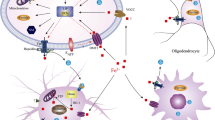Abstract
The aim of the study is to investigate the role of ATP-binding cassette subfamily B member 7 (ABCB7) in correlation with the progression of Parkinson’s disease. Initially, the neurotoxin 1-methyl-4-phenyl-1,2,3,6-tetrahydropyridine (MPTP) was used to develop a mouse model of mild and severe forms of Parkinson’s disease. Histology, immunohistology, and Western blotting were used to investigate the role of ABCB7 in disease progression. Mice injected with MPTP, at doses of 18 and 30 mg/kg for 10 and 15 consecutive days, respectively, developed mild and severe forms of Parkinson’s disease, respectively. Motor dysfunction is accessed through pole test in which, mild and severe forms of Parkinson’s disease developed mice takes 1.7 and 3.3 times more time to reach the floor than the control mice. Similarly, in rotarod test, the progression of Parkinson’s disease is evident with the progressive loss of motor stability. Histologically, the progression of Parkinson’s disease is evident with formation of cell aggregates in mild form; with the formation of more Lewy body structure and tissue hardening in a severe form of Parkinson’s disease. Immunohistochemistry showed gradual upregulation of ABCB7 in the cellular cytoplasm in mild stage Parkinson’s disease, while significant overexpression of ABCB7 was observed in the severe forms. Western blotting results confirmed 1.6- and 2.9-fold overexpression of ABCB7 in mild and severe forms of Parkinson’s disease, respectively. Collectively, the results showed that ABCB7 was present during Parkinson’s disease progression. However, upregulation of ABCB7 increased the cytoplasm level of the iron–sulfur complex, which negatively regulated the iron-dependent protein and can be used to determine the progression of Parkinson’s disease.






Similar content being viewed by others
References
Abramow-Newerly W, Lipina T, Abramow-Newerly M et al (2006) Methods to rapidly and accurately screen a large number of ENU mutagenized mice for abnormal motor phenotypes. Amyotroph Lateral Scler 7:112–118
Anderson MC, Green C (2001) Suppressing unwanted memories by executive control. Nature 410:366
Brønnick K, Alves G, Aarsland D et al (2011) Verbal memory in drug-naive, newly diagnosed Parkinson’s disease. The retrieval deficit hypothesis revisited. Neuropsychology 25:114
Cavadini P, Biasiotto G, Poli M et al (2006) RNA silencing of the mitochondrial ABCB7 transporter in HeLa cells causes an iron-deficient phenotype with mitochondrial iron overload. Blood 109:3552–3559
Christopher L, Marras C, Duff-Canning S et al (2013) Combined insular and striatal dopamine dysfunction are associated with executive deficits in Parkinson’s disease with mild cognitive impairment. Brain 137:565–575
Dunham NW, Miya TS (1957) A note on a simple apparatus for detecting neurological deficit in rats and mice. J Am Pharm Assoc 46:208–209
Hain EG, Klein C, Munder T et al (2016) Dopaminergic neurodegeneration in the mouse is associated with decrease of viscoelasticity of substantia nigra tissue. PLoS ONE 11:e0161179
Isaya G (2014) Mitochondrial iron–sulfur cluster dysfunction in neurodegenerative disease. Front Pharmacol 5:29
Lill R (2009) Function and biogenesis of iron–sulphur proteins. Nature 460:831
Lisman JE, Grace AA (2005) The hippocampal-VTA loop: controlling the entry of information into long-term memory. Neuron 46:703–713
Liu H, Chen S, Guo C et al (2018) Astragalus polysaccharide protects neurons and stabilizes mitochondrial in a mouse model of Parkinson disease. Med Sci Monit Int Med J Exp Clin Res 24:5192
Mariani S, Ventriglia M, Simonelli I et al (2013) Fe and Cu do not differ in Parkinson’s disease: a replication study plus meta-analysis. Neurobiol Aging 34:632–633
Meredith GE, Halliday GM, Totterdell S (2004) A critical review of the development and importance of proteinaceous aggregates in animal models of Parkinson’s disease: new insights into Lewy body formation. Parkinsonism Relat Disord 10:191–202
Meredith GE, Totterdell S, Potashkin JA, Surmeier DJ (2008) Modeling PD pathogenesis in mice: advantages of a chronic MPTP protocol. Parkinsonism Relat Disord 14:S112–S115
Mettert EL, Kiley PJ (2015) Fe–S proteins that regulate gene expression. Biochim Biophys Acta (BBA) Mol Cell Res 1853:1284–1293
Muñoz Y, Carrasco CM, Campos JD et al (2016) Parkinson’s disease: the mitochondria–iron link. Parkinsons Dis. https://doi.org/10.1155/2016/7049108
Ogawa N, Hirose Y, Ohara S et al (1985) A simple quantitative bradykinesia test in MPTP-treated mice. Res Commun Chem Pathol Pharmacol 50:435–441
Paul BT, Manz DH, Torti FM, Torti SV (2017) Mitochondria and Iron: current questions. Expert Rev Hematol 10:65–79
Piao Y-S, Lian T-H, Hu Y et al (2017) Restless legs syndrome in Parkinson disease: clinical characteristics, abnormal iron metabolism and altered neurotransmitters. Sci Rep 7:10547
Pondarré C, Antiochos BB, Campagna DR et al (2006) The mitochondrial ATP-binding cassette transporter Abcb7 is essential in mice and participates in cytosolic iron–sulfur cluster biogenesis. Hum Mol Genet 15:953–964
Salazar J, Mena N, Hunot S et al (2008) Divalent metal transporter 1 (DMT1) contributes to neurodegeneration in animal models of Parkinson’s disease. Proc Natl Acad Sci 105:18578–18583
Schlossmacher MG, Tomlinson JJ, Santos G et al (2017) Modelling idiopathic Parkinson disease as a complex illness can inform incidence rate in healthy adults: the PREDIGT score. Eur J Neurosci 45:175–191
Sofic E, Riederer P, Heinsen H et al (1988) Increased iron (III) and total iron content in post mortem substantia nigra of parkinsonian brain. J Neural Transm 74:199–205
Zhang T, Yu S, Guo P et al (2016) Nonmotor symptoms in patients with Parkinson disease: a cross-sectional observational study. Medicine (Baltimore) 95:e5400
Zhang Q, Heng Y, Mou Z et al (2017) Reassessment of subacute MPTP-treated mice as animal model of Parkinson’s disease. Acta Pharmacol Sin 38:1317–1328
Author information
Authors and Affiliations
Contributions
HC, YB: study design; WT: collected the samples; HC, YB: laboratory work; All authors: contributed to the manuscript, read, and approved the final manuscript.
Corresponding author
Ethics declarations
Conflict of interest
The authors of this work declare that they have no conflict of interest.
Ethical statement
Animal used in the experiments and protocols followed were approved by Institutional ethical and animal care committee.
Rights and permissions
About this article
Cite this article
Chi, H., Tang, W. & Bai, Y. Molecular evidence of impaired iron metabolism and its association with Parkinson's disease progression. 3 Biotech 10, 173 (2020). https://doi.org/10.1007/s13205-020-2162-1
Received:
Accepted:
Published:
DOI: https://doi.org/10.1007/s13205-020-2162-1




